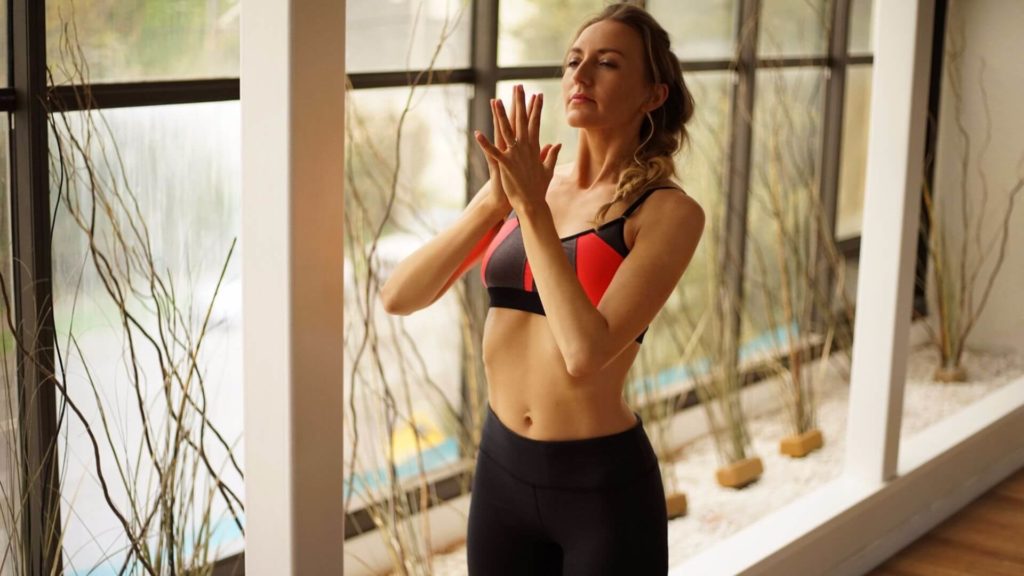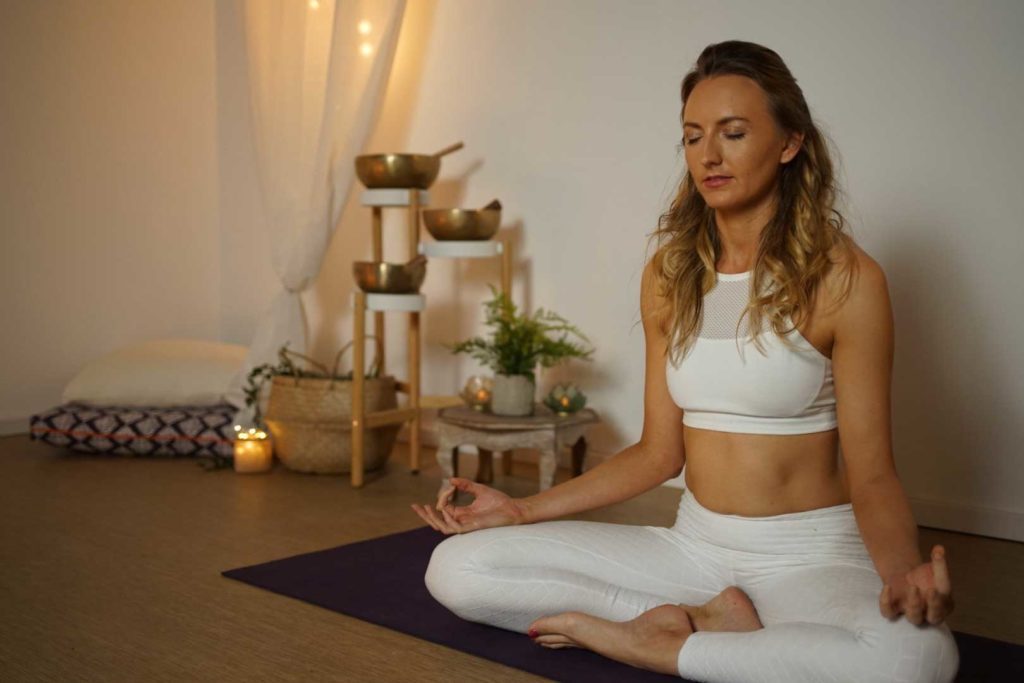
Hands up if your life is exactly perfect in every way and you have everything you’ve ever wanted and nothing bad has ever happened in your life.
Yeah, me neither.
But here’s the thing: That doesn’t mean I don’t like my life! It doesn’t mean I’m not happy with where my life is!
Sure, I’d be disappointed if I don’t get the job I really wanted or I’d be really sad if a close relative or friend passes away, but I’m not going to fight those emotions and I can still be content with my life.
How do I manage this?
For one, a great yoga community! But I also practice Santosha, the second of the five Niyamas from Patanjali’s yoga sutras. In this article, we’ll dive into the origins of Santosha, a contemporary take on the yogic philosophy of happiness, and finally, how to bring it to life on your yoga mat and out in the world.
What is Santosha?

The word Santosha is most commonly translated from Sanskrit as contentment. Note that our goal here isn’t happiness, but a more subtle state of mind.
Santosha is the second niyama, a group of principles that form the second part of Patanjali’s eight limbs of yoga, following the yamas. As you might have read, the eight limbs aim to cultivate a state of inner peace, one that is free of attachment to outcomes or outer circumstances.
When your teacher starts yoga class by asking you to bring awareness to your breathing without trying to change it, have you noticed how easy it is in that moment to let go of your expectations and just enjoy being in your body? That is Santosha.
Santosha encourages us to bring that simple enjoyment into our daily life experience, no matter what events throw us off course. Practicing contentment might seem strange at first because it goes against the mainstream idea that we always have to be more to be happy. But the thing is, gaining more skills, more money, or more stuff just for the sake of having more doesn’t actually affect your mental and emotional state.
In practice, Santosha must be balanced with other principles of yoga philosophy in order to help you along your way rather than hold you back. Patanjali’s text tells us that Yoga is achieved when the mind becomes steady, clear, and single-pointed. In yoga sutra I.33, Patanjali describes this approach as keeping the mind “at peace”. Here is a Sanskrit translation by Dr.Kausthub Desikachar:
If we can be happy for those who are happier than ourselves, offer compassion towards those who are not as happy as we are, show appreciation towards those whose actions are praiseworthy, and hold an attitude of equanimity towards those who sin, our minds will remain at peace.
When Patanjali compiled the yoga sutras around the third century BC, Indian leaders were debating the importance of India’s social classes, known as the caste system. Some linked an individual’s karma, the sum of a person’s actions in this and previous lives, to their caste rank, which emboldened people of the highest classes to claim a divine right to rule over people of the lower classes.
At the time, attempting to force contentment with poor living conditions based on moral high ground kept power dynamics in place, and framed those who challenged the status-quo as morally degenerate. Political manipulation aside, in modern practice it’s important to understand contentment as an active yoga practice that should contribute to your freedom and happiness. It’s not meant to restrain you and require you to accept everything even if you disagree with it.
Contentment vs. Complacency

This brings us to our next distinction when it comes to Santosha because even though you may see them used in similar ways, contentment and complacency are definitely not the same things!
With contentment, you’re actively differentiating between situations you can and cannot change. You’re genuinely content with your current situation. It’s probably not perfect, but you’re still actively looking for ways to improve too and you’re happy with that process too.
Complacency becomes more of a forced or fake type of happy.
Let’s imagine that you’re putting some of this knowledge about Santosha, contentment to work. Back in yoga class, you’re able to put negative feelings aside, open your heart, and smile when instructed. Maybe you’re even finding an inner state of calm off the mat–flowing along from present moment to moment, while trusting the universe to make decisions for you. You become the person in all your relationships who allows others to get their way. Everything is easier if you don’t rock the boat! …But is this contentment?
The truth is, one of the most difficult things about practicing Santosha for many students of yoga is to stand up for themselves. Although practicing contentment involves accepting whatever life situation you may be facing, it can still involve working to make change and having ambition.
So, how do you know if you’ve become complacent? Ask yourself these questions:
- Is your experience of contentment conditional upon avoiding conflict?
- Are you always giving in to what others desire in order to keep the peace?
- Do you feel you’ve sacrificed joy and happiness, “settling” for contentment instead?
- Are you living with unresolved feelings?
- Are you content to trade self-development for an easy solution?
If you answered “yes” to even one of these questions, it’s time to re-evaluate. You might need to review the second yama, Satya (translated from Sanskrit as truth), before you keep working at Santosha.
Choosing contentment should never be a sacrifice. True contentment satisfies the soul on the deepest of levels, leading to a more lasting happiness than most of us are used to, and guiding you along the path to enlightenment.
How to Practice Santosha Today
Now you know about some mistakes yogis make when practicing Santosha, but how do you successfully practice it? Here are four practices to build your competence with the second niyama.
Meditation

Mantra meditation is useful for replacing obsessive thoughts about food cravings, unfulfilled desire, a lack of self-acceptance, or the quest for material possessions. This meditation will boost your overall satisfaction and improve your relationship to unhelpful thoughts. It’s like taking a mini-retreat in your mind!
Here’s how you do it:
- Set a timer for 20 minutes
- Find a seat in an environment where you won’t be disturbed
- Close your eyes and take a few deep, slow breaths
- Inhale: “I am,
- Exhale: …enough”
- End the practice by releasing the meditation and sitting in silence for a few moments
Gratitude Practice

This practice is one of the most popular ways to explore the concept of Santosha for those who enjoy writing. The aim is to cultivate a genuine feeling of happiness and desire for the things that you already have.
Set aside 10 minutes in your day, and write down everything in the world you can think of that contributes to your happiness. What things in life make you content with little or no effort on your part?
Start simple (think: house, school, health, job ) and let yourself get creative (the time between seasons when there is no end and no beginning). Listing material possessions is totally fair game here. You won’t fuel greed if you focus on what makes you truly content.
Gratitude is a simple, yet powerful practice when it comes from the heart. You may feel a great deal of gratitude in your life and still struggle with this, but don’t worry. Putting words to a feeling is a skill, and you’ll improve with practice.
Sama Vritti Pranayama

Sama Vritti is one of the first breathing techniques you learn in yoga and is simple enough to teach to children (family yoga, anyone?). Yoga’s sister science, Ayurveda, an Indian medicinal practice dating back 5,000 years emphasizes the importance of healthy breathing and it really works: the Navy SEALs have famously used Sama Vritti, or “box breath”, in basic officer training.
Navy SEAL or not, Sama Vritti is an effective method for calming anxiety and a great way to practice Santosha!
This is how you do it:
- Set a timer for 5 minutes
- Take a seat that allows you to hold a straight spine
- Inhale for a count of 5
- Hold (full lungs) for a count of 5
- Exhale for a count of 5
- Hold (empty lungs) for a count of 5
- Continue until the timer rings
Hanumanasana (Full Front Split or Wherever Your Body Allows)

Santosha is your best friend when seeking any kind of sustainable improvement in your asana practice. If you aren’t content with your present physical abilities, you will struggle to improve them if you waste energy battling with self-acceptance. A lot of yogis don’t address this point until injury, illness, or other circumstances set them back in their physical practice. Do yourself a favor, and practice Santosha before you need to.
Hanumanasana (splits) is a challenging pose. Approach it like an adventure to the edge of your comfort zone, where you’ll work to maintain a state of ease and self-compassion. Have a variety of props on hand before you begin, including at least two yoga blocks, a couple of blankets, and perhaps a bolster. When you’ve gathered your props, let’s begin:
- Start in a low lunge with the back knee padded by a blanket if needed, and props at the ready
- Ardha Hanumanasana: Shift your hips back until your front leg is straight, with the foot flexing – use blocks for balance if you can’t reach the ground
- Either stay in Ardha Hanumanasana, or begin sliding the front heel forward while keeping the hips as square as possible. Pad the hips with your props as needed
- If possible, bring your palms together in prayer position at the heart and cultivate a deep acceptance of where you are in the pose
Next Steps
- If you’re interested in learning the three skills that empower you to embody your yoga off the mat to get the results you desire in your personal life, check out my Yoga for Self Mastery course.
- Explore my knowledge hub for How to Become a Yoga Teacher or consider becoming a Somatic Yoga Coach in my newest certification program.
- Practice yoga with me on my YouTube channel with over a thousand free classes.
Experience 3 Training Videos from Inside My 200-Hour Online YTT

YOU MIGHT ALSO LIKE
- What is Kriya Yoga? The Philosophy and Practice
- Uddiyana Bandha: Tapping Into Your Deep Core
- 4 Reasons Hasta Bandha Is Essential To Your Yoga Practice
- Vitarka Mudra: What It Is and How Do You Use It?
- Shakti Mudra: What It Is and How Do You Do It?
- Garuda Mudra: What It Is and How Do You Use It?
- Kali Mudra: What It Is and How Do You Do It?
- Shunya Mudra: What It Is and How Do You Do It?
- Varuna Mudra: What It Is and How Do You Use It?
- Vayu Mudra: What It Is and How Do You Use It?
- Samana Vayu: The Energy of Balance & How to Access It
- Apana Vayu: The Energy of Release & Surrender
- Udana Vayu: The Ascending Wind
- Prana Vayu: The Breath of Vitality
- Vyana Vayu: The Energetic Secret to Flow
Learn how to do 11 of the most popular yoga poses correctly. Free video + PDF download.











